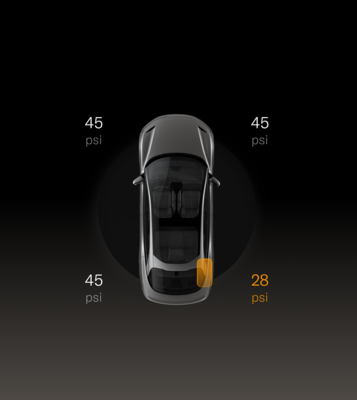Tire Pressure Monitoring System (TPMS)
The TPMS monitors the pressure of the tires using sensors located in each wheel. In-vehicle sensors receive TMPS data using Radio Frequency (RF) signals.
![]() Tire pressure warnings are displayed on the Glass Cockpit via an amber warning indicator. A warning chime will sound, and a warning message will display to alert you to a problem.
Tire pressure warnings are displayed on the Glass Cockpit via an amber warning indicator. A warning chime will sound, and a warning message will display to alert you to a problem.
The tire pressure warning indicator will illuminate if a tire is under-inflated.
If the tire pressure warning indicator illuminates, stop and check your tires as soon as possible, and inflate the tires to the correct pressure if necessary. The cause must be determined and rectified if the tire pressure warning frequently occurs.
Tire Pressure Information Display

TPMS Malfunction
Your vehicle is equipped with a TPMS malfunction indicator to indicate when the system is not properly operating.
The TPMS malfunction indicator is combined with the low tire pressure indicator. The indicator will flash for approximately one minute when the system detects a malfunction, and then the indicator will remain continuously illuminated. This sequence will continue upon subsequent vehicle start-ups as long as the malfunction exists.
The system may not be able to detect or signal low tire pressure as intended when the malfunction indicator is illuminated. TPMS malfunctions may occur for a variety of reasons, including the installation of replacement or alternate tires or wheels on the vehicle that prevents the TPMS from functioning properly. Always check the TPMS malfunction indicator after replacing one or more tires or wheels on your vehicle to ensure that the replacement or alternate tires and wheels allow the TPMS to properly function.
Tire Pressure Correction
The tire pressure indicator light does not turn off right away after adjusting the tire pressure on all four tires. After you have inflated your tires to their correct pressures, drive your vehicle at a speed of at least 18 mph (30 km/h) to activate the Tire Pressure Monitoring System (TPMS) and reset the low tire pressure indicator light.
Tire Changing
Always have your tires serviced or changed by a qualified technician.
After tires are changed, drive your vehicle for 10 minutes to allow the system to learn and locate new sensor(s) and their position(s).
Replacing a Tire Pressure Sensor
If you receive frequent low tire pressure warnings despite the tire pressures being correct, contact the Lucid Service Center to determine if a tire pressure sensor replacement is necessary.
After installing a new sensor, drive your vehicle for 10 minutes to allow the system to learn and locate new sensor(s) and their position(s).
Replacing a Tire Pressure Monitor System Battery
When the Tire Pressure Monitor System (TPMS) battery is depleted, the entire TPMS sensor must be replaced at an authorized service center. The battery cannot be replaced separately. Contact Customer Care to schedule a service for replacement.